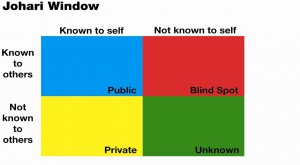A great way to improve your leadership skills is by determining your “blind spot.” The below model is known as the Johari Window (more info can be found on its definition athttp://en.wikipedia.org/wiki/Johari_window ) and is a great tool to use when reviewing leadership. The key to figuring out your blind spot is understanding the distinct color coded quadrants. Let’s take a look at each.

The top left (blue) quadrant of the window deals with things that are “Public” in nature. This means both you and others would agree on the type of leaders you are. Here is an example. Let’s say you are a vocal and passionate leader who openly expresses opinions. If both you and others are aware of this truth than it is public knowledge and no surprise to anyone.
The bottom left (yellow) category deals with leadership skills that are “Private” in nature (known only to you) and not known by others. An example could be that your strongest desire is not to serve as a volunteer leader anymore because you have come to realize that simply do not enjoy it. However, others would never think this could be true because you are a person (to them) who seemingly thrives on and loves serving as a volunteer leader. So in this case we have information that is known to you but unknown to others.
The bottom right (green) quadrant is referred to as “Unknown”. These are things we all speculate about but do not have the answers to. Ex: If you take a leadership course will you become a better leader? If you take a volunteer leadership role in the community– will you become a better speaker? You get the idea. So this area of the window is referred to as “Unknown” because only the future will reveal the answer.
And, finally the one you have all been waiting for which is the top right (red) category. This is referred to as the Blind Spot. The Blind Spot defines something that is known to or seen by others but not known to or seen by you. This quadrant of the “window” provides a huge growth opportunity for all levels of leaders. Moreover, any leader who is unaware of his/her “blind spot” is truly operating in the dark .
Here are a couple of examples that will help. Lets say you view your leadership style as too passive however others see it as “pushy and obnoxious.” What if you think of yourself as a person who is great at delegating things however others view you as a person who wants to micromanage every part of a project. A blind spot in our leadership style is no different than the blind spot we cannot see when backing our car up.
Something is there but we cannot see it. Understanding and improving your blind spot is a great way to embrace your current and overall leadership skills. After all, leaders must first lead themselves in a successful manner before they can lead others. In closing, do you know what your blind spot is? If not, there is no better time that now to find out. Ask other leaders around you and be open to hearing what they have to say. After all, those who improve in this area today will become better leaders tomorrow.
Ryan T. Sauers



 ©
©